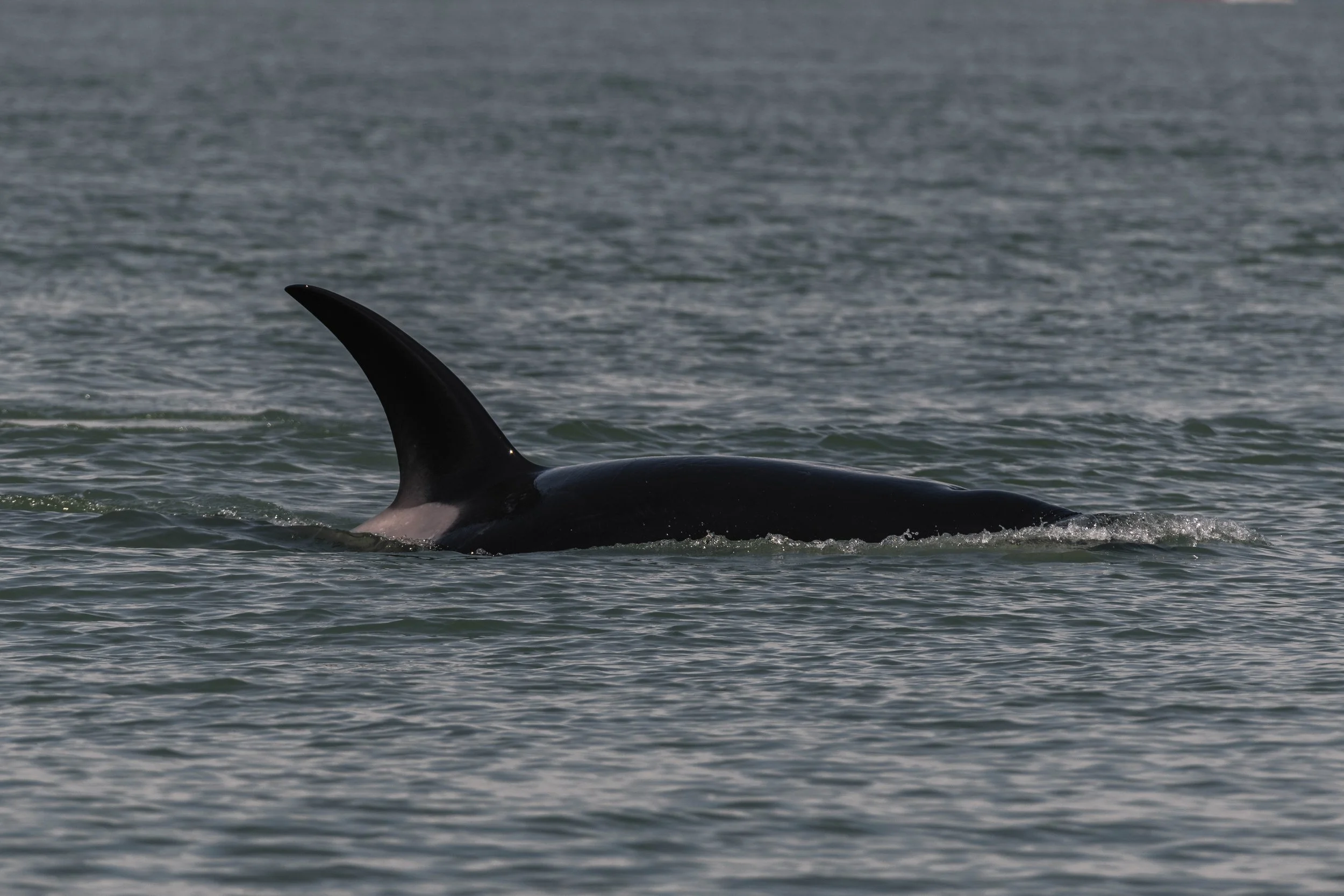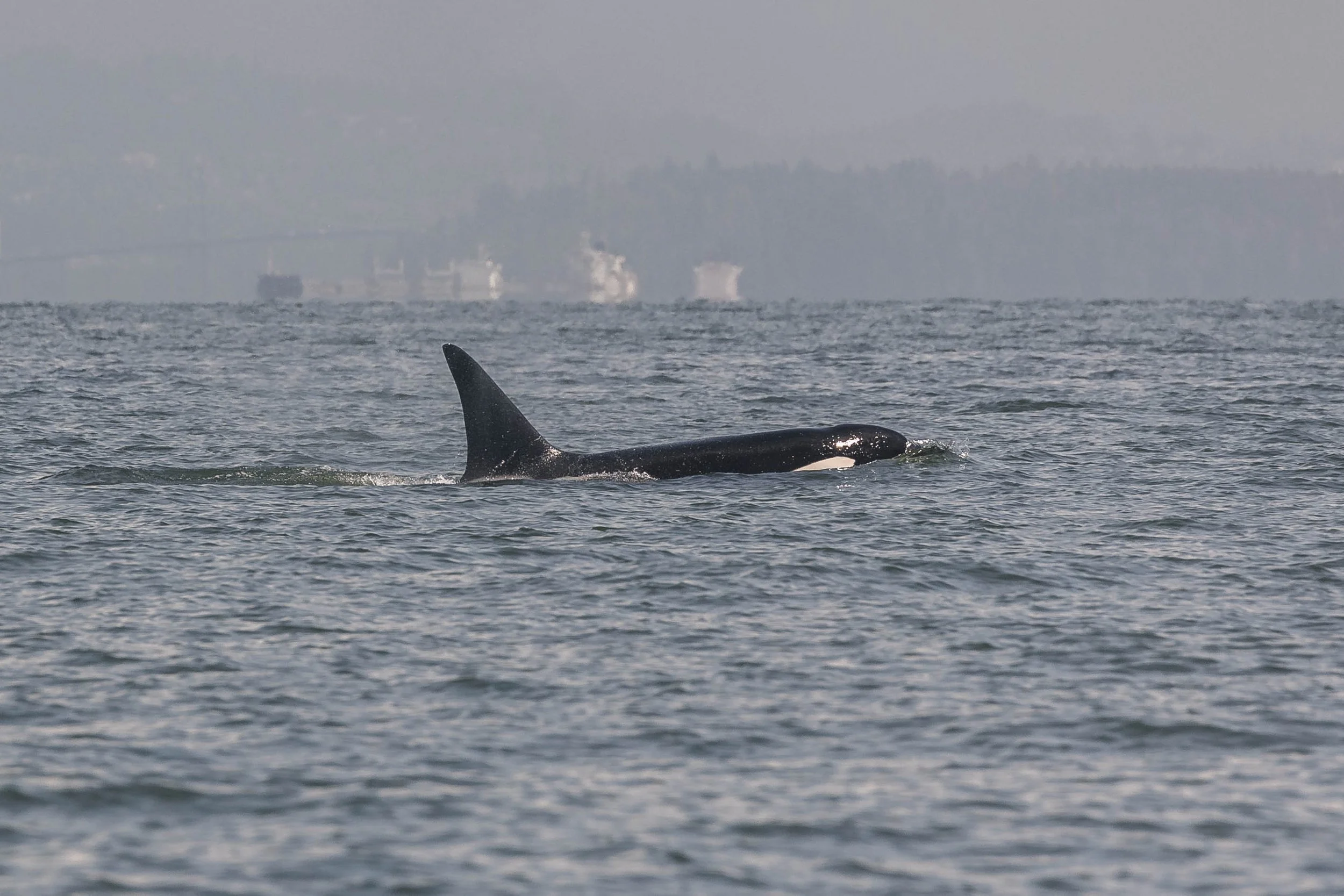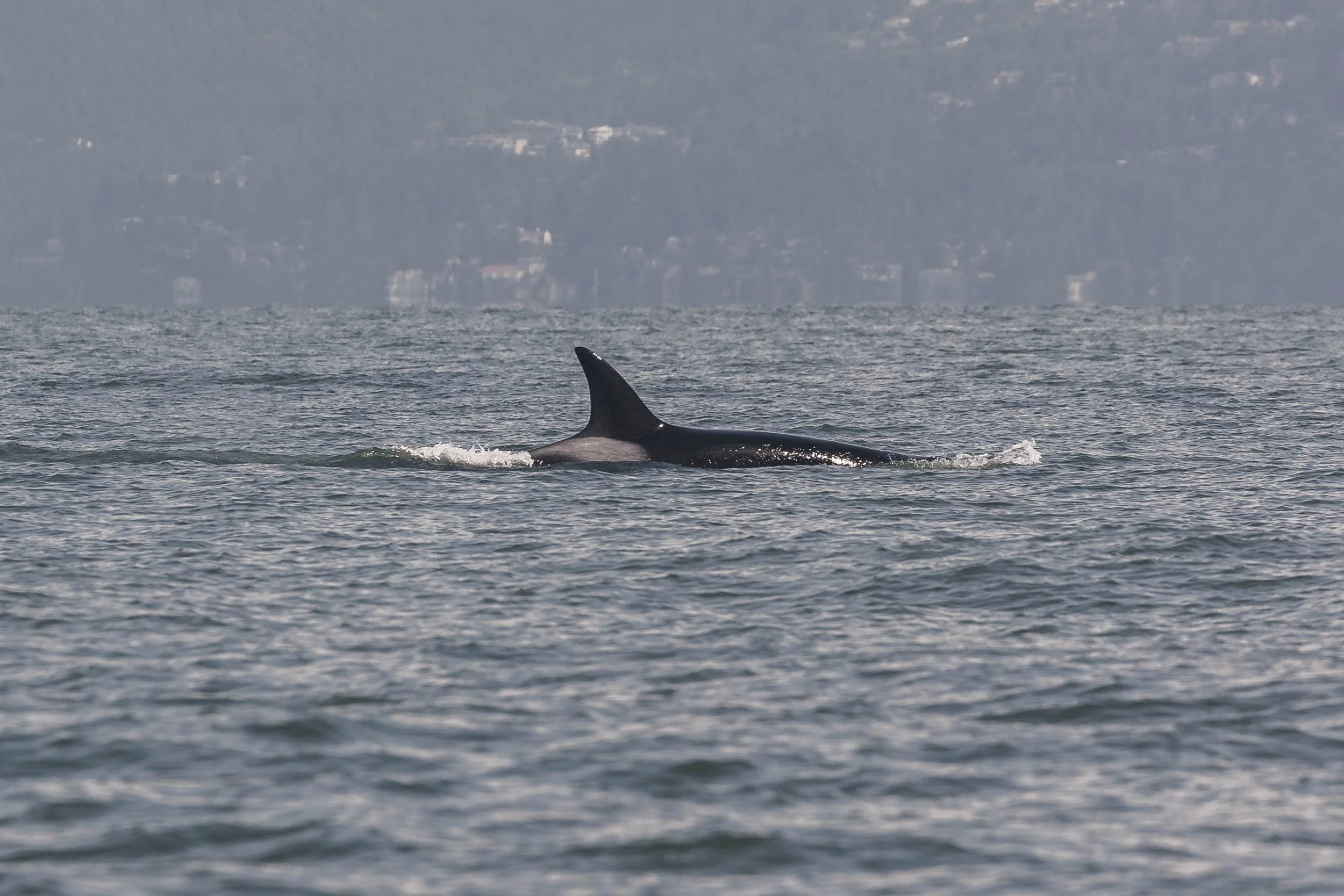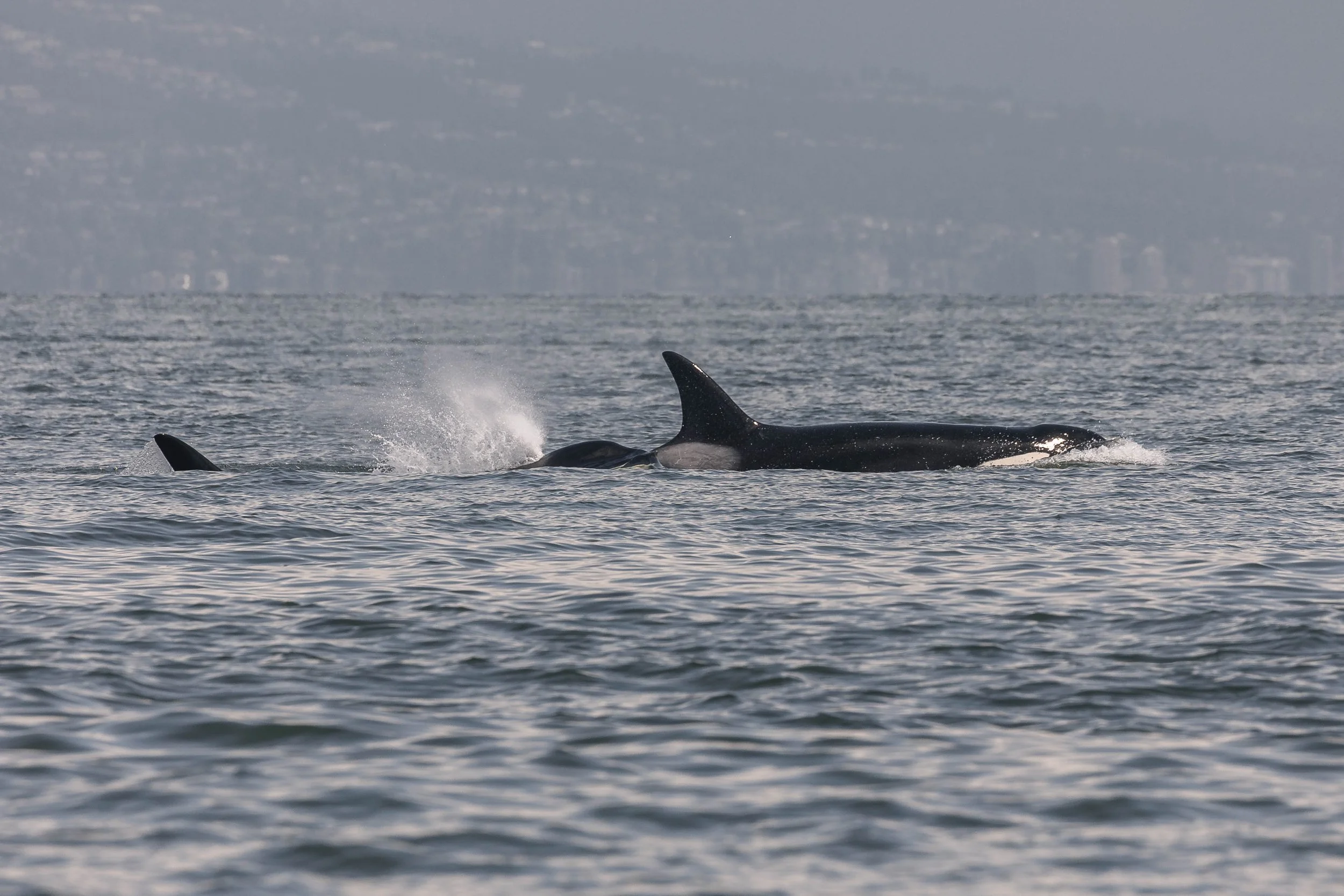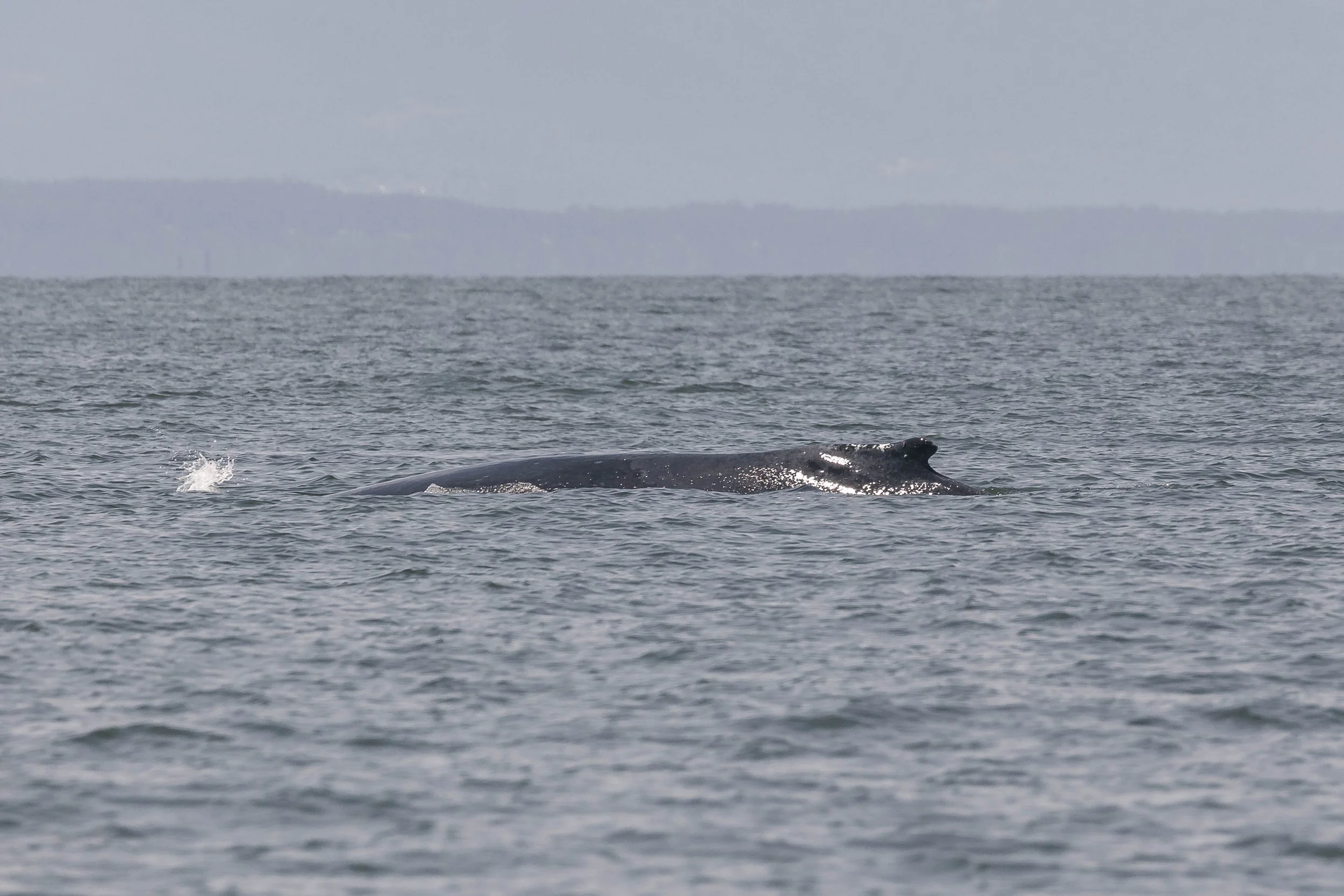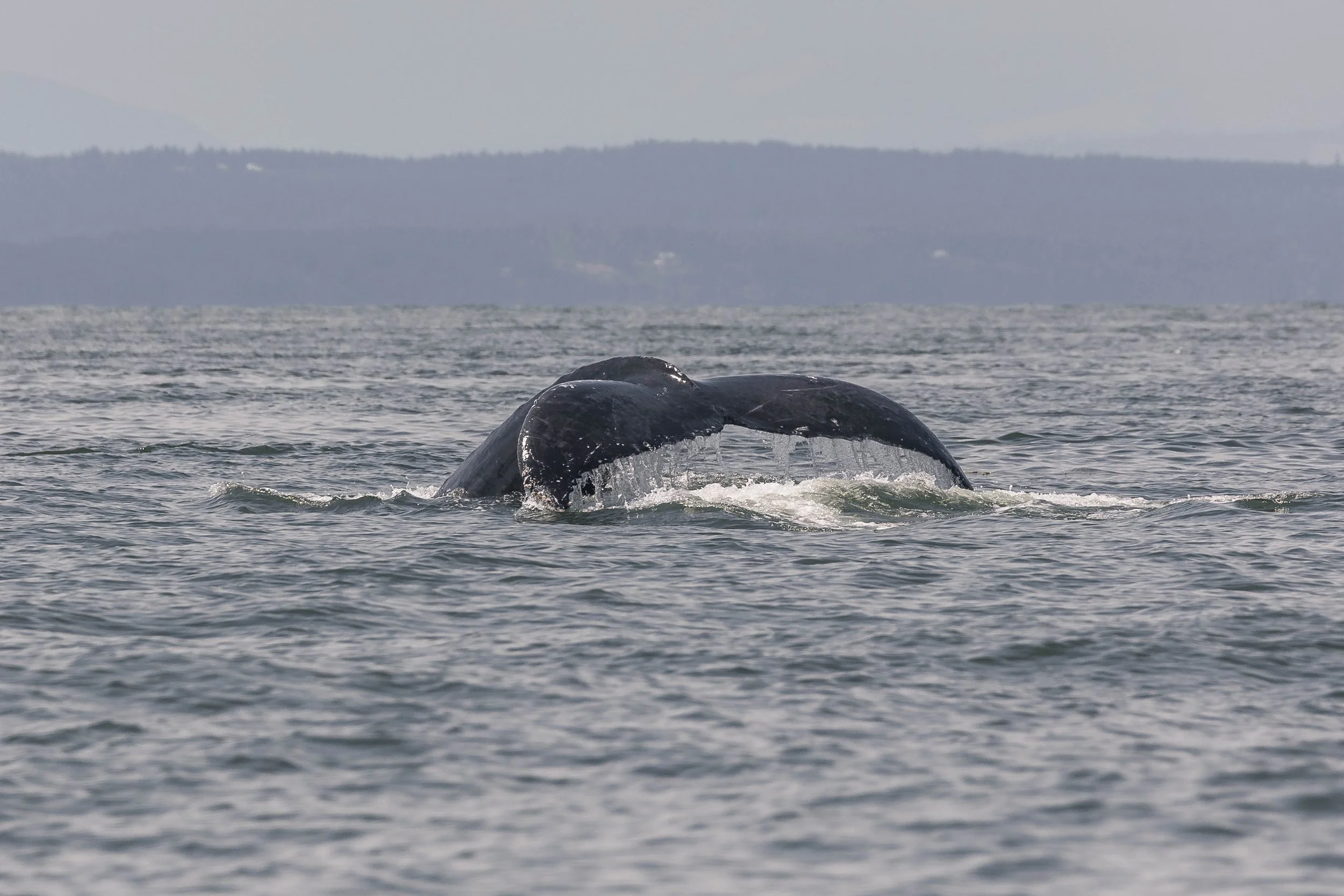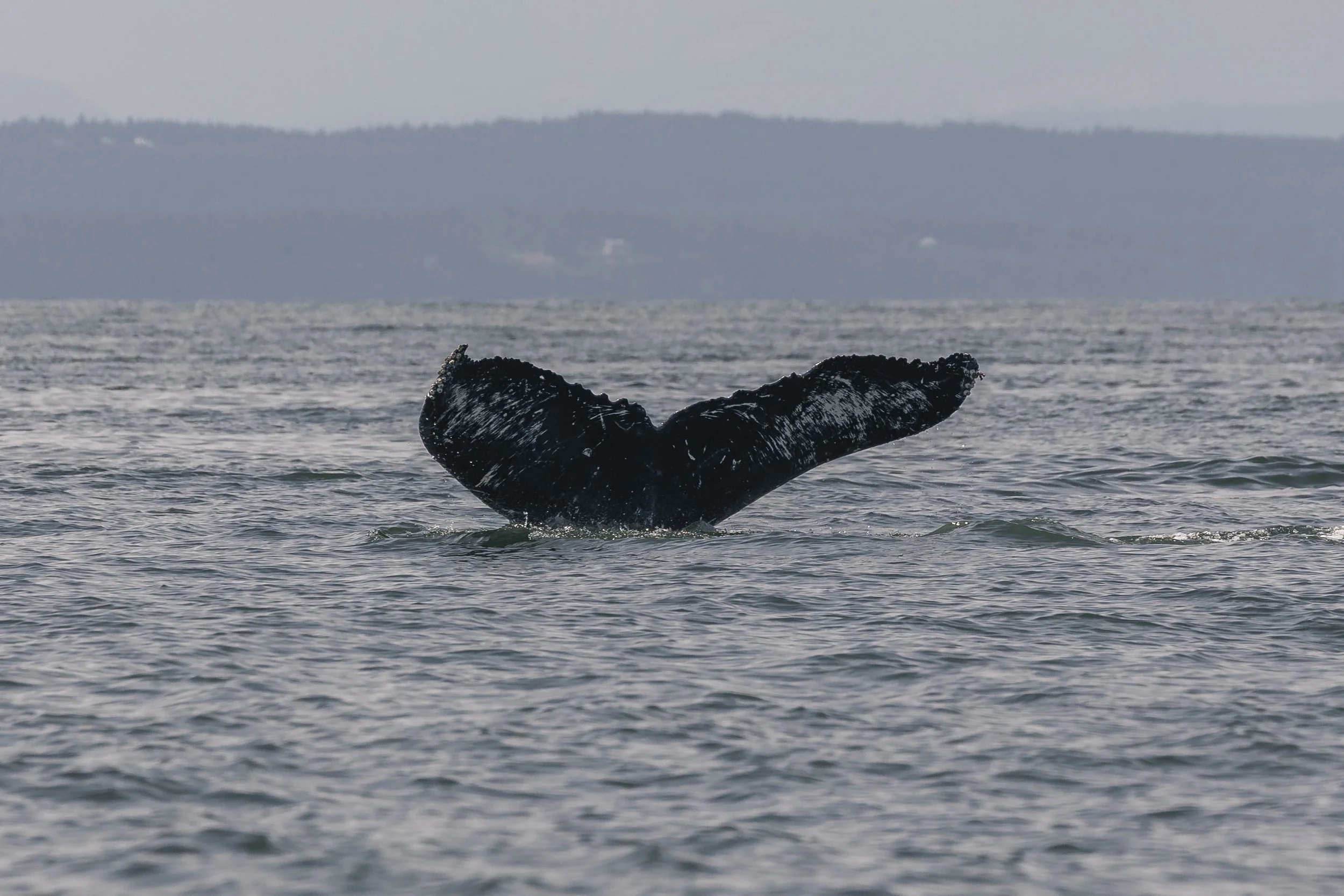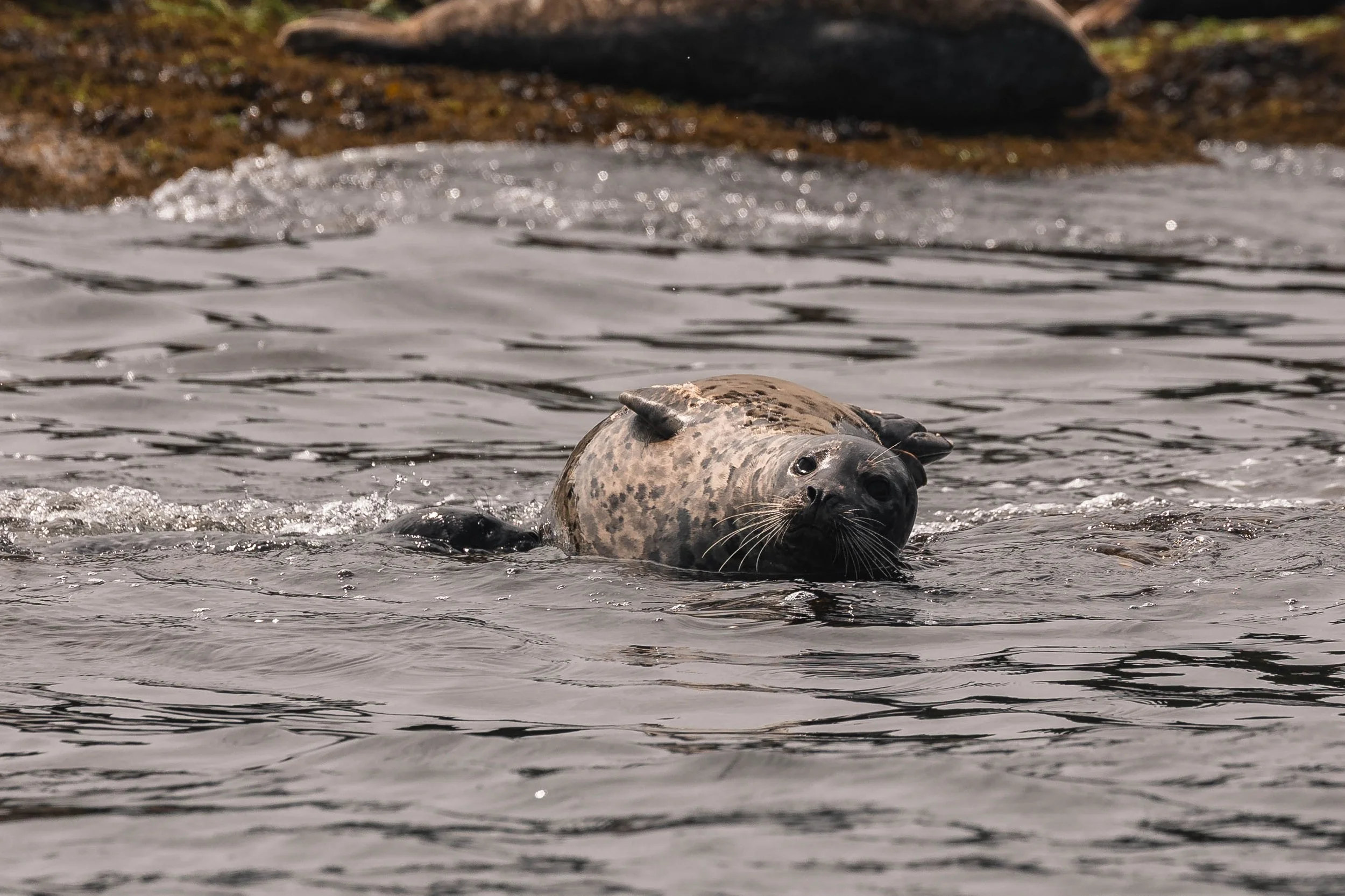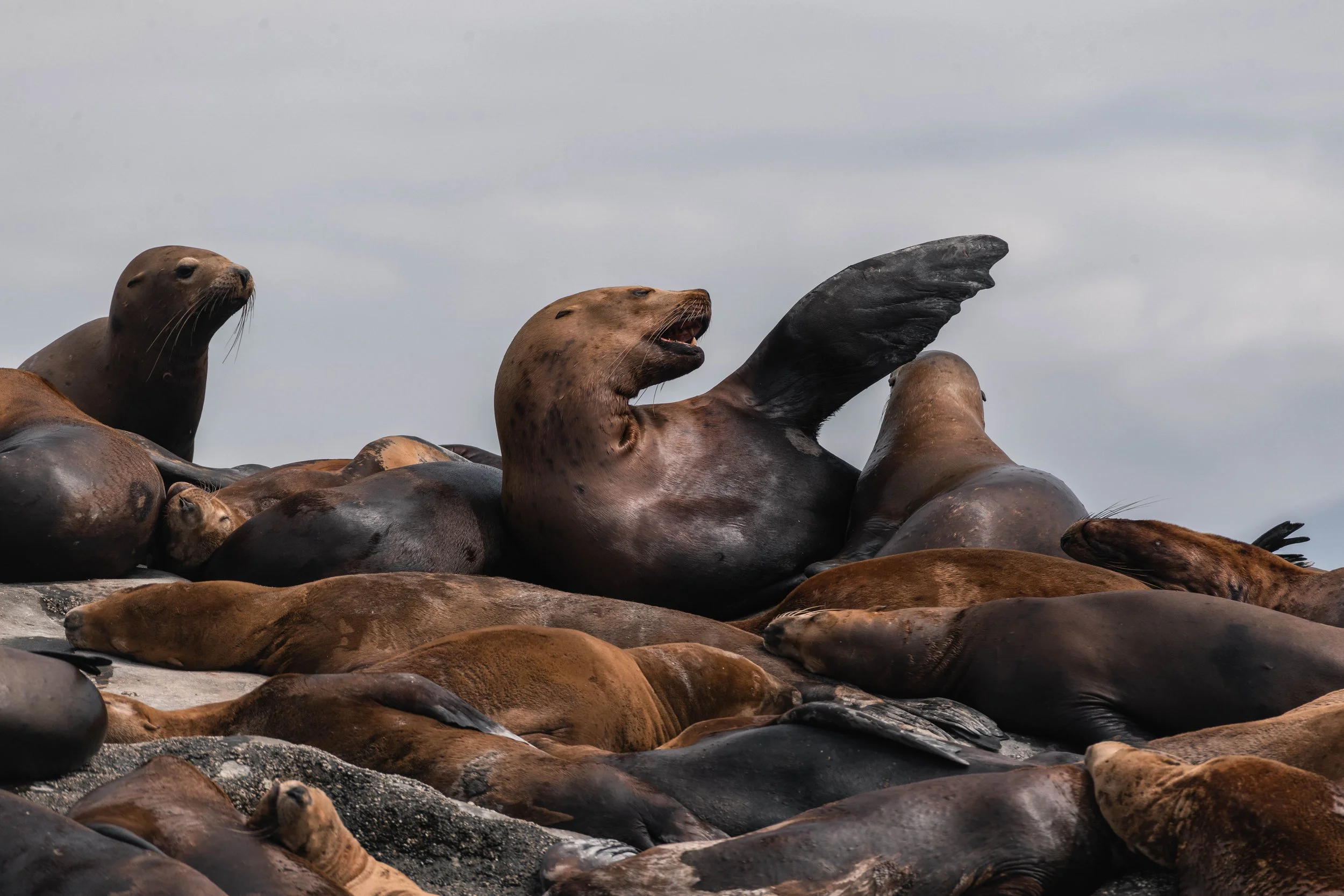July 10, 2025, 10:30 AM - Three humpbacks and a full on T-party in the SOG.
The full fleet was out, the sun was out, and so were the whales. We started our search today in the Strait of Georgia, first coming across a popular sea lion and harbour seal haul-out we call Stinky Rocks.
One of the most unforgettable parts of encountering seal and sea lion haul-outs isn’t just the sight or sound, it’s the smell! These rocky outcrops and coastal ledges where pinnipeds gather in large numbers are often thick with the pungent scent of fishy breath, oily fur, and a heavy dose of marine mammal poop. Their diet, which consists almost entirely of fish, octopus and squid, results in strong-smelling waste that quickly builds up in communal resting areas. Add in the warmth of the sun and the sheer number of animals packed together, and it's no wonder these haul-outs can carry an impressively bad, and unmistakably oceanic, odour! We moved on to get some fresh air flowing past our noses again as we continued our search for our whales.
Back into the Strait we went, eager to spot our gentle giants or their nemesis, the wolves of the sea! First up, we found a giant, it was Strike (BCX1675), a female humpback we recognized almost instantly. Strike holds a special place in our hearts as she hung around the same area in the Gulf Islands when pregnant with her calf, now named Thunderbolt. She was most likely focused on feeding, as evidenced by her long dives during this encounter. We left Strike to her lunch and carried on across the Strait.
We spotted something else near Bowen Island. There were multiple blows in multiple directions, we had stumbled upon the transient orca and not just one, we had a party! The orca present were:
T035A Lester ♀ (1998)
T035A1 Opal ♀ (2010)
T035A2 Topaz ♂ (2013)
T035A3 Garnet (2018)
T035A4 ♂ (2022)
T037A1 Inyo ♀ (2007)
T038A Dana ♀ (2000)
T038A2 (2020)
T038A3 (2024)
T065 Whidbey II ♀ (~1971)
T063 Chainsaw ♂ (~1978)
T065B Chunk ♀ (1993)
T065B1 Birdsall ♂ (2011)
T065B2 Nettle/Corvus ♂ (2019)
T065B3 Rook ♂ (2023)
T077 Asja ♀ (1981)
T077C Neftali ♂ (2006)
T077D Alycon ♀ (2009)
T077E Misneach (2016)
Every now and then, we’re lucky enough to witness something truly special on the water a T-party. No, not the kind with teacups and scones, but a social gathering of transient or (Bigg’s) orca from multiple family groups, often referred to by scientists as a “T-party” because the individuals involved are all catalogued with the letter “T.”
Transient orca are typically seen in small, tight-knit family units, usually made up of a mother and her offspring. They’re stealthy, marine-mammal hunters that rely on surprise and silence to catch prey like harbour seals, sea lions, porpoises and baleen whales. Because of this hunting style, they’re often spread out and quiet, making large gatherings rare. But sometimes, conditions line up perfectly in the Salish Sea, an abundance of food, calm waters, and possibly even social or reproductive motivations, and these families converge.
During a T-party, we’ll often see unusually playful behaviour from these apex predators: breaching, tail slapping, socializing, and vocalizing more than usual. It’s a striking contrast to their usual low-profile behaviour. These get-togethers might serve multiple purposes, strengthening social bonds between groups, allowing young whales to interact and learn, or giving mature individuals the chance to find potential mates. Whatever the reason, a T-party is always a thrilling and unforgettable experience for everyone onboard.
After enjoying being a part of the festivities, we were back into search mode heading west back towards home when one of the boats spotted a pair of humpbacks, it was Chinook (BCY0996) and Iota (BCY1466). Our humpbacks often return to our waters with new scarring on their bodies, both Chinook and Iota sport scars. Let’s go back to what I said earlier about the orca being the nemesis of the gentle giants. It is because the orca hunts the humpbacks!
Every so often, we're reminded that even the largest animals in the ocean aren't entirely safe. One of the more dramatic interactions we occasionally witness on the water is between humpback whales and transient orca. These orca specialize in hunting marine mammals and are known for their intelligence, teamwork, and adaptability. Around the world, there are documented cases of orca successfully hunting humpback calves, usually younger or more vulnerable individuals. So naturally, when these two species cross paths in the Salish Sea, there’s a noticeable tension in the air.
In recent years, we’ve seen an uptick in these kinds of interactions in our local waters. There have been several close encounters: orca pursuing humpbacks, tail slapping displays, dramatic surfacings, and even moments where it appears the orca are testing the humpbacks’ response. These events are incredibly rare and intense to witness. However, despite the rising number of sightings and seemingly aggressive behaviour, there has never been a confirmed successful humpback predation event in the Salish Sea.
Some researchers believe the increase in encounters may be linked to the growing populations of both species, as well as overlapping feeding territories. Others suggest that younger orca may be “practicing” or learning about their potential prey. Whatever the reason, these encounters often end with the humpback standing its ground, using its massive size, powerful tail, and unpredictability to deter the orca. While the threat is real, for now, the humpbacks of the Salish Sea appear to be holding their own.
After an extremely lucky day, not only getting to see double species but also witnessing a T-party it was time to head back home! Enjoy the photos below taken by Aly Kohlman, Cheyenne Brewster and Hayleigh Hilbert.
Strike’s dorsal fin. Photo by Cheyenne Brewster.
Strike lifting her tail out of the water. Photo by Aly Kohlman.
T077D Alycon behind T037A1 Inyo. Photo by Aly Kohlman.
Look at the deep scarring on Birdsall’s saddle patch! Photo by Aly Kohlman.
Dana’s baby T038A3 following close behind her. Photo by Aly Kohlman.
Family photo. Photo by Aly Kohlman.
T038A Dana has a big white patch at the base of her dorsal fin making her easy to spot! Photo by Aly Kohlman.
T065B Chunk has a notch at the base of her dorsal making her easy to identify. Photo by Aly Kohlman.
T065B1 Birdsall. Photo by Aly Kohlman.
An interesting angle of T063 Chainsaw’s dorsal fin. Photo by Aly Kohlman.
T063 Chainsaw. Photo by Aly Kohlman.
T063 Chainsaw. Photo by Aly Kohlman.
T063 Chainsaw. Photo by Aly Kohlman.
T063 Chainsaw. Photo by Aly Kohlman.
T035A Lester. Photo by Aly Kohlman.
T035A2 Topaz. Photo by Aly Kohlman.
T077C Neftali looks very round from this angle. Photo by Cheyenne Brewster.
T077 Asja. Photo by Cheyenne Brewster.
Picking up speed! Photo by Hayleigh Hilbert.
A sideways whale sticking their pectoral fin up. Photo by Hayleigh Hilbert.
T077 Asja surfacing. Photo by Hayleigh Hilbert.
Tails up! Photo by Hayleigh Hilbert.
A little jump! Photo by Hayleigh Hilbert.
T065B1 Birdsall with a bouncing baby popping up beside him. Photo by Hayleigh Hilbert.
T077C Neftali. Photo by Hayleigh Hilbert.
T077D Alycon. Photo by Hayleigh Hilbert.
T077 Asja. Photo by Hayleigh Hilbert.
Neftali is a sprouting male, meaning his dorsal fin is in a growth period as he goes through puberty. Photo by Hayleigh Hilbert.
Mom, T077 Asja, with her son, T077C Neftali, just surfacing behind. Photo by Hayleigh Hilbert.
T077D Alycon followed by T37A1 Inyo. Photo by Hayleigh Hilbert.
T077 Asja. Photo by Hayleigh Hilbert.
T077C Neftali. Photo by Hayleigh Hilbert.
T077D Alycon. Photo by Hayleigh Hilbert.
T077 Asja. Photo by Hayleigh Hilbert.
T077D Alycon surfacing with big brother T077C Neftali’s dorsal fin beside her. Photo by Hayleigh Hilbert.
T077E Misneach. Photo by Hayleigh Hilbert.
Iota’s dorsal fin. Photo by Hayleigh Hilbert.
Chinook’s dorsal fin. Photo by Hayleigh Hilbert.
A fluke waterfall from Chinook’s tail. Photo by Hayleigh Hilbert.
A look at the unique markings on the underside of Chinook’s tail. Photo by Hayleigh Hilbert.
Harbour Seals hauled out on the rocks. Photo by Aly Kohlman.
A pup nursing from mom. Photo by Hayleigh Hilbert.
Mount Baker is that way. Photo by Aly Kohlman.
A large male Stellar Sea Lion at Stinky Rock. Photo by Hayleigh Hilbert.
This smaller sea lion looks like they had a lot to say. Photo by Hayleigh Hilbert.
















